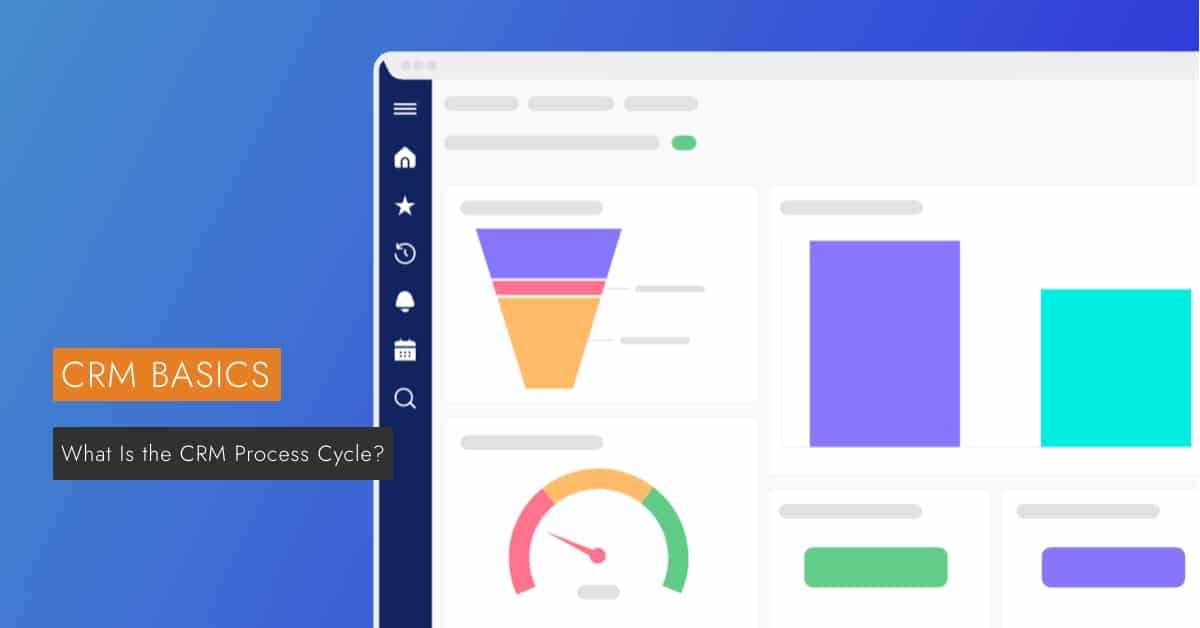What Is the CRM Process Cycle?

A “CRM process cycle” is the term used to describe the four main stages of a customer’s experience with your organization, from marketing to customer service and retention.
All CRM software products have features that reflect the typical CRM process cycle: Marketing, sales, orders, and customer service. Many CRM software product features enable customization to better reflect any unique stages of your company’s CRM process cycle.
In this post, we’ll discuss each stage of the CRM process cycle, and which software features can help businesses in these stages.
How the CRM Process Cycle Benefits Your Business
In short, the CRM cycle helps you make better business decisions and provide more meaningful customer experiences. Each stage in the process reflects a customer’s lifecycle, which helps you understand your clients and encourage customer loyalty.
The Difference Between a Customer Lifecycle and the CRM Process Cycle
While these two terms are very similar, they vary greatly when it comes to approach and execution.
A customer lifecycle represents each stage a person goes through starting from product awareness and ending with brand loyalty. Even after a prospect becomes a customer, they’ll go through the same lifecycle if they ever consider buying your product again. The hopeful end result is customer loyalty and brand ambassadorship.
The CRM cycle, on the other hand, represents the processes a business goes through to guide a customer through the lifecycle. For example, if step one of a customer lifecycle is brand awareness, then step one of the CRM process cycle is marketing.
Let’s take a closer look at the four major steps of the CRM process and the various software tools designed to help your business find, convert, and keep your customers.
#1: Marketing
The first step is all about raising brand awareness and acquiring leads. You want to generate interest with various marketing strategies and segment your target audience to create content that speaks to them. In order to do that, you need to acquire leads through magnets, blog posts, social media posts, and newsletters.
It seems like the number of marketing tools are endless. Not all CRM editions come with a full suite of marketing tools and features, so as always, we recommend doing your homework to find a CRM that offers the marketing features you need.
CRM Tools for Better Marketing
- Automated lead assignment rules
- Lead scoring and tracking
- Landing page builder
- Lead segmentation
- Activity tracking
- Social media campaign builder and interactions tracker
- Email template builder
- A/B testing and analytics
- Third-party email integration (Outlook, Gmail, MailChimp, Constant Contact, etc.)
#2: Sales
The second step of the cycle is the transactional or sales stage. By now, your prospects have turned into leads. They’ve researched your product, compared your brand to your competitors, read customer reviews and articles, and are genuinely interested in buying.
Depending on what you sell, this stage can be quite long. Generally, B2B customers take a while to get to this point. If you’ve made it this far, your sales reps can use data from your CRM’s customizable sales stages to more accurately predict the probability of closing, and therefore focus their efforts on the leads that are most likely to buy.
CRM Tools for More Sales
- Visual sales pipeline
- Interactive drag-and-drop tools
- Contact management
- Self-defined sales stages
- Automation
- Sales forecasting
- Analytics and reporting
- Quote Management and Creation
#3: Orders
You’ve officially closed a deal. Now you need to focus on delivering the product. Today’s customers want to be able to track their product shipments and feel confident that their order will arrive on time.
CRM tools keep all your product information under one roof to ensure successful and seamless order fulfillment. A CRM can help you stay on top of your inventory and delivery and communicate effectively with your warehouse and distribution team.
CRM Tools for Product Management
- Product and product bundle management
- Warehouse management
- Packing and distribution management
#4: Customer Service
Whether you’re an emerging technology company selling the latest B2C products or you supply the latest B2B software as a service, you want to make sure your clients are always satisfied. With a CRM software, your sales and customer service teams can anticipate a client’s needs and quickly resolve issues on the first call.
Great client care isn’t just about putting out fires. You also want your clients to feel that their continued patronage is appreciated. The customer service stage of the CRM process is also a chance for your team to upsell your products, encourage customer referrals and turn your clients into brand ambassadors.
One of the best ways to maintain excellent customer service is by tracking and logging your customer interactions all in one place. For example, Veloxity’s activity timeline shows your team a complete communication history of all your contacts, including leads.
CRM Tools for Better Customer Service
- Help desk and ticketing
- Live chat or AI chatbot
- Customer portal
- Activity timeline
- Third-party email integration
Find a CRM That Delivers the Tools You Need
A great customer relationship management software is loaded with tools to help your customer through the lifecycle. It’s also designed to help your sales teams and customer service reps improve customer satisfaction and maintain your customer’s positive relationship with your brand.
If you’re looking for a software product that can simplify your sales processes and keep your customer data organized, check out Veloxity CRM. Our wide range of sales, marketing, and analytics tools can help you attract high-quality leads, convert more customers, and improve client satisfaction. Start your free trial today!
